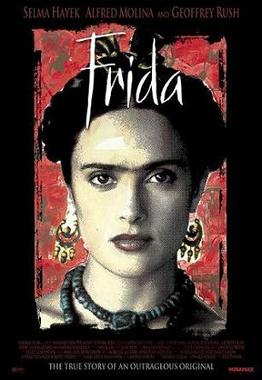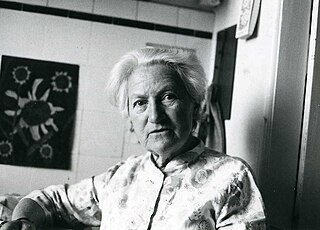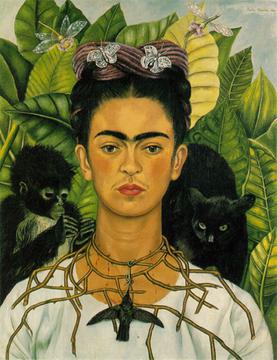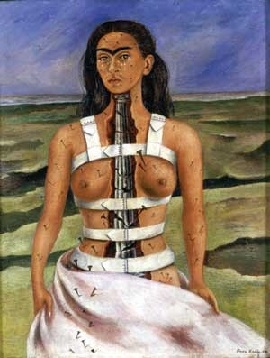
Magdalena Carmen Frida Kahlo y Calderón was a Mexican painter known for her many portraits, self-portraits, and works inspired by the nature and artifacts of Mexico. Inspired by the country's popular culture, she employed a naïve folk art style to explore questions of identity, postcolonialism, gender, class, and race in Mexican society. Her paintings often had strong autobiographical elements and mixed realism with fantasy. In addition to belonging to the post-revolutionary Mexicayotl movement, which sought to define a Mexican identity, Kahlo has been described as a surrealist or magical realist. She is also known for painting about her experience of chronic pain.

Frida is a 2002 American biographical drama film directed by Julie Taymor which depicts the professional and private life of the surrealist Mexican artist Frida Kahlo.

Wolfgang Robert Paalen was an Austrian-Mexican painter, sculptor, and art philosopher. A member of the Abstraction-Création group from 1934 to 1935, he joined the influential Surrealist movement in 1935 and was one of its prominent exponents until 1942. Whilst in exile in Mexico, he founded his own counter-surrealist art-magazine DYN, in which he summarized his critical attitude towards radical subjectivism and Freudo-Marxism in Surrealism with his philosophy of contingency. He rejoined the group between 1951 and 1954, during his sojourn in Paris.
Events from the year 1937 in art.

Guillermo Kahlo was a German-Mexican photographer. He photographically documented important architectural works, churches, streets, landmarks, as well as industries and companies in Mexico at the beginning of the 20th century; because of this, his work has not only artistic value but also historical and documental importance. He was the father of painter Frida Kahlo.

Lucienne Bloch was a Switzerland-born American artist. She was best known for her murals and for her association with the Mexican artist Diego Rivera, for whom she produced the only existing photographs of Rivera's mural Man at the Crossroads, painted in 1933 and destroyed in January 1934 at Rockefeller Center in New York City.

Jacqueline Lamba was a French painter and surrealist artist. She was married to the surrealist André Breton.

Dorothy Hale was an American socialite and aspiring actress who died by jumping off of the Hampshire House building in New York City. Her husband's death, followed by several unsuccessful relationships, had left her financially dependent on her wealthy friends. The artist Frida Kahlo created a famous painting commissioned by Clare Boothe Luce, titled The Suicide of Dorothy Hale.

Alice Phillipot (Alice Rahon) (8 June 1904 – September 1987) was a French-born Mexican poet and artist whose work contributed to the beginning of abstract expression in Mexico. She began as a surrealist poet in Europe but began painting in Mexico. She was a prolific artist from the late 1940s to the 1960s, exhibiting frequently in Mexico and the United States, with a wide circle of friends in these two countries. Her work remained tied to surrealism but was also innovative, including abstract elements and the use of techniques such as sgraffito and the use of sand for texture. She became isolated in her later life due to health issues.

Women Surrealists are women artists, photographers, filmmakers and authors connected with the surrealist movement, which began in the early 1920s.
Myra Bairstow is an American writer and independent art scholar and curator. She was the co-author and director of the Manierre Dawson Catalogue Raisonné in collaboration with the Hollis Taggart Galleries published in 2011. Bairstow's curatorial exhibitions with the Taggart Galleries include "Manierre Dawson: American Pioneer of Abstract Art", "Manierre Dawson: New Revelations" (Chicago) and "Manierre Dawson" A Catalogue Raisonné.

Self-Portrait with Monkey is an oil on masonite painting by Mexican artist Frida Kahlo, commissioned in 1938 by A. Conger Goodyear, then president of the Museum of Modern Art in New York City. It is one of the many self-portraits painted by Kahlo for friends and patrons during her career.

The Two Fridas is an oil painting by Mexican artist Frida Kahlo. The painting was the first large-scale work done by Kahlo and is considered one of her most notable paintings. It is a double self-portrait, depicting two versions of Kahlo seated together. One is wearing a white European-style Victorian dress while the other is wearing a traditional Tehuana dress. The painting is housed at the Museo de Arte Moderno in Mexico City.

What the Water Gave Me is an oil painting by Frida Kahlo that was completed in 1938. It is sometimes referred to as What I Saw in the Water.

Self-Portrait with Thorn Necklace and Hummingbird is a 1940 self-portrait by Mexican painter Frida Kahlo which also includes a black cat, a gorilla and two dragonflies. It was painted after Kahlo's divorce from Diego Rivera and the end of her affair with photographer Nickolas Muray.

The Broken Column is an oil on masonite painting by Mexican artist Frida Kahlo, painted in 1944 shortly after she had spinal surgery to correct on-going problems which had resulted from a serious traffic accident when she was 18 years old. The original is housed at the Museo Dolores Olmedo in Xochimilco, Mexico City, Mexico.

Self-Portrait Dedicated to Leon Trotsky, also known as Between the Curtains, is a 1937 painting by Mexican artist Frida Kahlo, given to Leon Trotsky on his birthday and the 20th anniversary of the October Revolution. Kahlo and her husband, artist Diego Rivera, had convinced government officials to allow Trotsky and his second wife, Natalia Sedova, to live in exile in Mexico. The Russian couple moved into the Blue House (La Casa Azul), where they resided for two years.

Self-portrait in a Velvet Dress is a 1926 oil-on-canvas painting by Mexican artist Frida Kahlo.

Frida is a 2024 documentary film directed by Carla Gutierrez about the life of Mexican painter Frida Kahlo. As Gutierrez's directorial debut, it was first shown at the 2024 Sundance Film Festival where it won the U.S. Documentary Jonathan Oppenheim Editing Award.
















